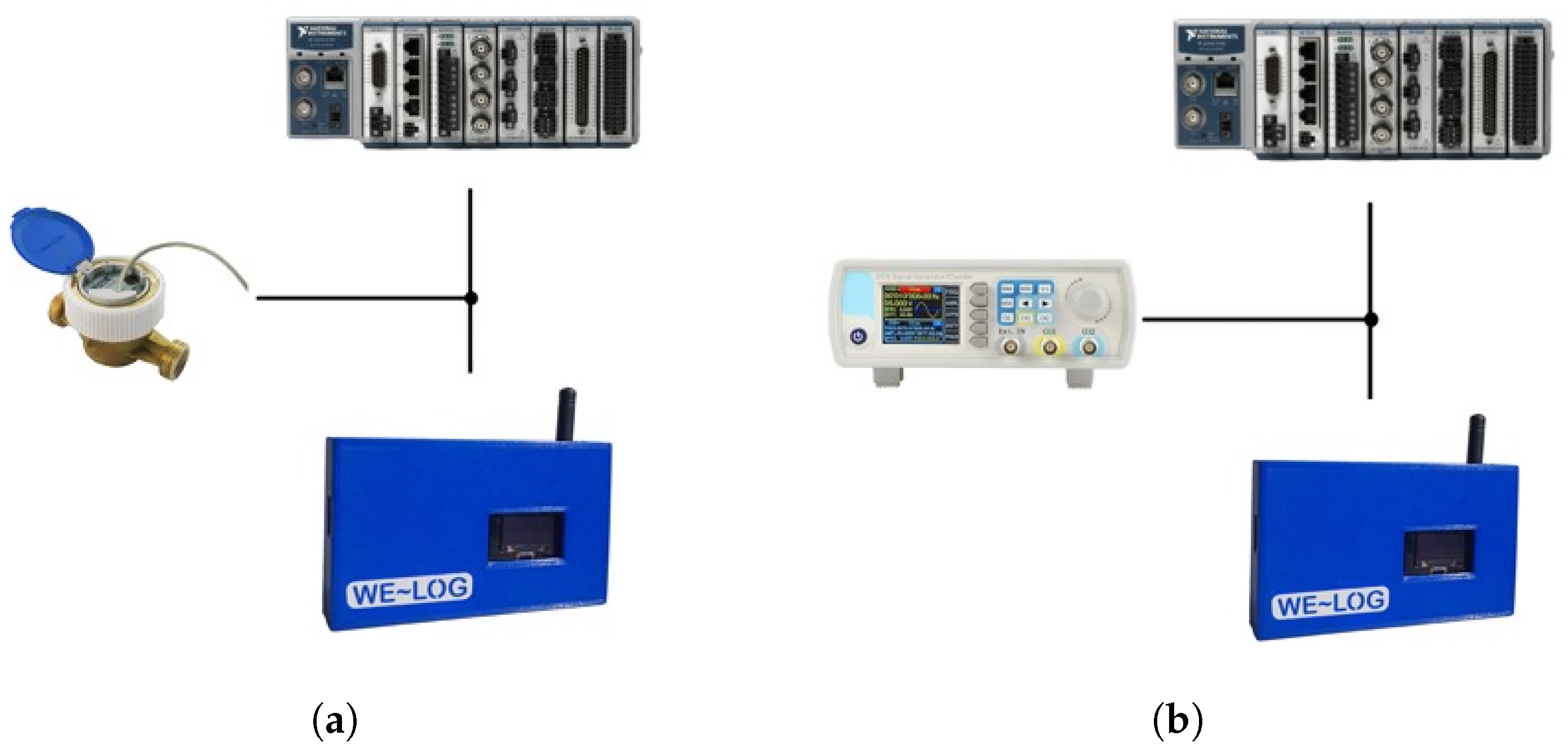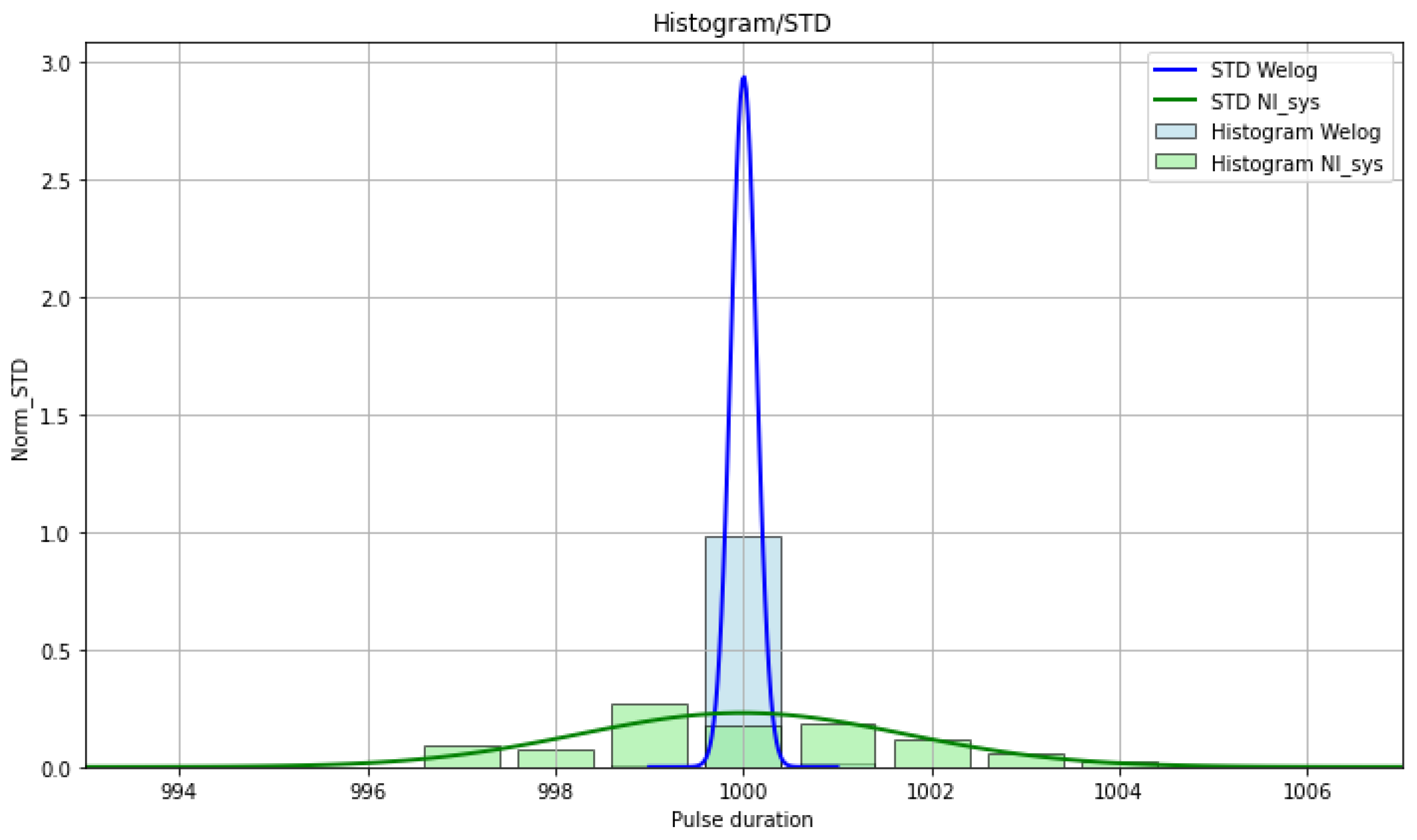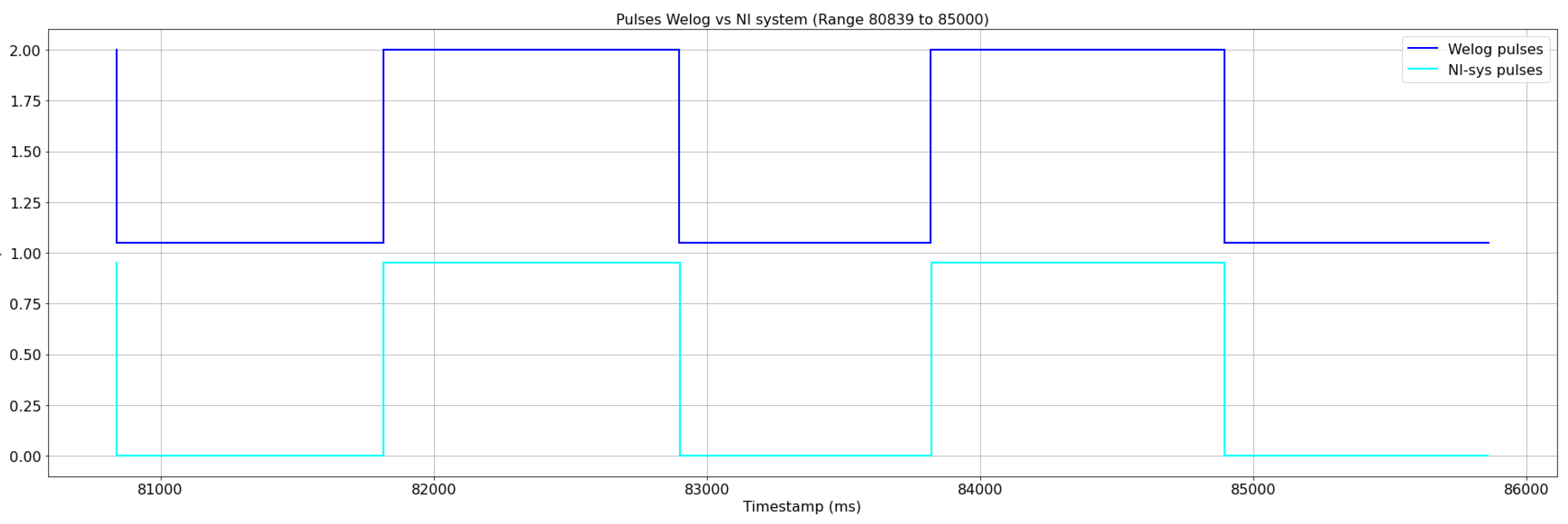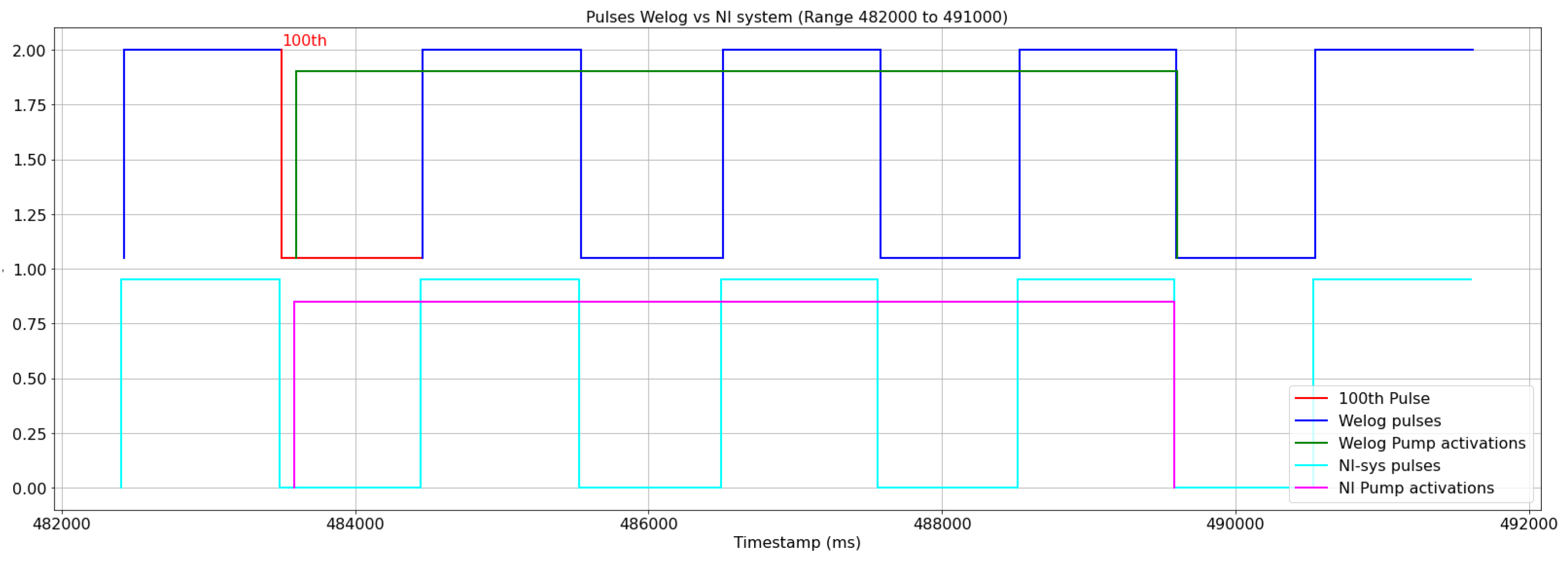A Device for Controlling the Chlorination in Small Umbrian Water Distribution Systems
Abstract
:1. Introduction
2. Materials and Methods
2.1. Device Characteristics and Study Relevance
- The acquisition of pulses for measurements from flow meters;
- The control of peristaltic pumps or similar devices, commonly used in chlorination;
- The measurement of physical parameters such as water temperature;
- Logging and control with different sampling frequencies of other quantities (e.g., levels, pH, etc.) from various measuring digital devices;
- Remote monitoring;
- Low energy consumption;
- Low cost.
2.2. The Device
- Two connectors for DS1820 temperature digital one-wire sensors (manufactured by Analog Devices) with an accuracy of ±0.5 °C, with the possibility of connecting additional sensors to the same connectors;
- Six inputs for digital or analog signals, each individually configurable as pull-up or pull-down;
- One Inter-Integrated Circuit (I2C) connector to add additional devices;
- One relay-controlled clean contact (Normally Open–Normally Closed, NO-NC) to control the chlorination pump, allowing the activation of devices with power requirements that cannot be directly handled by the microcontroller;
- One serial port for a GlobalTop PA6H global positioning system (GPS) receiver.
2.3. The Tests
2.3.1. Tests with Pulse Generator
2.3.2. Tests with Water Meter
2.3.3. Tests with Thermometers
2.3.4. Tests of LoRa Transmission
2.3.5. Tests with GPS
3. The Results
3.1. The Pulse Generator and the Noise Reduction
- A maximum pulse frequency of the water meter of about 1 Hz, which roughly corresponds to a square wave of 500 ms in the 0 state and 500 ms in the 1 state;
- The measured spikes have a duration of less than 1 ms;
- The board is capable of acquiring digital channels at a frequency of approximately 1.8 MHz.
3.2. Water Meter
3.3. Temperature
3.4. Other Tests
4. Conclusions
Author Contributions
Funding
Data Availability Statement
Acknowledgments
Conflicts of Interest
References
- Autorita di Regolazione per Energia Reti e Ambiente (Italian Regulatory Authority for Energy Networks and Environment, ARERA). Technical Quality Regulation of the Integrated Water Service and Each Componing Services (in Italian, Regolazione della Qualità Tecnica del Servizio Idrico Integrato Ovvero di Ciascuno dei Singoli Servizi che lo Compongono (RQTI)—Deliberazione 917/2017/R/IDR). 2017. Available online: https://www.arera.it/atti-e-provvedimenti/dettaglio/17/917-17 (accessed on 24 September 2024).
- Poleneni, S.; Inniss, E. Small Water Distribution System Operations and Disinfection By Product Fate. J. Water Resour. Prot. 2013, 5, 35–41. [Google Scholar] [CrossRef]
- Schal, S.L. Water Quality Sensor Placement Guidance for Small Water Distribution Systems. Ph.D. Thesis, University of Kentucky, Lexington, KY, USA, 2013. [Google Scholar]
- Garcia-Avila, F.; Aviles-Añazco, A.; Guerrero, M.; Arévalo, P.; Pinos-Velez, V. Effects of temperature, pH, and turbidity on the disinfection kinetics of chlorine in drinking water. Water 2020, 12, 354. [Google Scholar] [CrossRef]
- Banna, M.H.; Imran, S.; Francisque, A.; Najjaran, H.; Sadiq, R.; Rodriguez, M.; Hoorfar, M. Online Drinking Water Quality Monitoring: Review on Available and Emerging Technologies. Crit. Rev. Environ. Sci. Technol. 2014, 44, 1370–1421. [Google Scholar] [CrossRef]
- Thakur, A.; Devi, P. A Comprehensive Review on Water Quality Monitoring Devices: Materials Advances, Current Status, and Future Perspective. Crit. Rev. Anal. Chem. 2024, 54, 193–218. [Google Scholar] [CrossRef] [PubMed]
- Fisher, I.; Kastl, G.; Sathasivan, A. Evaluation of suitable chlorine bulk-decay models for water distribution systems. Water Res. 2011, 45, 4896–4908. [Google Scholar] [CrossRef] [PubMed]
- Jones, R.; Patel, P. Solar-powered chlorination systems for small-scale water treatment. Renew. Energy 2017, 105, 324–331. [Google Scholar] [CrossRef]
- Alam, A.U.; Clyne, D.; Deen, M.J. A Low-Cost Multi-Parameter Water Quality Monitoring System. Sensors 2021, 21, 3775. [Google Scholar] [CrossRef] [PubMed]
- Bogdan, R.; Paliuc, C.; Crisan-Vida, M.; Nimara, S.; Barmayoun, D. Low-Cost Internet-of-Things Water-Quality Monitoring System for Rural Areas. Sensors 2023, 23, 3919. [Google Scholar] [CrossRef] [PubMed]
- Zeng, R.; Mannaerts, C.M.; Shang, Z. A Low-Cost Digital Colorimetry Setup to Investigate the Relationship between Water Color and Its Chemical Composition. Sensors 2021, 21, 6699. [Google Scholar] [CrossRef] [PubMed]
- Smith, J.; Williams, D.; Green, A. Challenges in implementing sensor-driven chlorination systems in rural areas. J. Water Resour. Plan. Manag. 2015, 141, 04015027. [Google Scholar] [CrossRef]
- Ferrante, M.; Rogers, D.; Casinini, F.; Mugabi, J. A Laboratory Set-Up for the Analysis of Intermittent Water Supply: First Results. Water 2022, 14, 936. [Google Scholar] [CrossRef]
- Ferrante, M.; Rogers, D.; Mugabi, J.; Casinini, F. Addressing Water Meter Inaccuracies Caused By Intermittent Water Supply: A Laboratory Investigation of Remedial Measures. Water Resour. Manag. 2023, 37, 3921–3933. [Google Scholar] [CrossRef]
- Ferrante, M.; Rogers, D.; Mugabi, J.; Casinini, F. A Laboratory Investigation on the Effects of Intermittent Water Supply and Remedial Measures. Water Resour. Res. 2024, 60, e2023WR035282. [Google Scholar] [CrossRef]
- ISO 4064-1:2017; Water Meters for Cold Potable Water and Hot Water—Part 1: Metrological and Technical Requirements. International Organization for Standardization: Geneva, Switzerland, 2017. Available online: https://www.iso.org/standard/55371.html (accessed on 24 September 2024).









Disclaimer/Publisher’s Note: The statements, opinions and data contained in all publications are solely those of the individual author(s) and contributor(s) and not of MDPI and/or the editor(s). MDPI and/or the editor(s) disclaim responsibility for any injury to people or property resulting from any ideas, methods, instructions or products referred to in the content. |
© 2024 by the authors. Licensee MDPI, Basel, Switzerland. This article is an open access article distributed under the terms and conditions of the Creative Commons Attribution (CC BY) license (https://creativecommons.org/licenses/by/4.0/).
Share and Cite
Casinini, F.; Ferrante, M. A Device for Controlling the Chlorination in Small Umbrian Water Distribution Systems. Water 2024, 16, 2747. https://doi.org/10.3390/w16192747
Casinini F, Ferrante M. A Device for Controlling the Chlorination in Small Umbrian Water Distribution Systems. Water. 2024; 16(19):2747. https://doi.org/10.3390/w16192747
Chicago/Turabian StyleCasinini, Francesco, and Marco Ferrante. 2024. "A Device for Controlling the Chlorination in Small Umbrian Water Distribution Systems" Water 16, no. 19: 2747. https://doi.org/10.3390/w16192747









